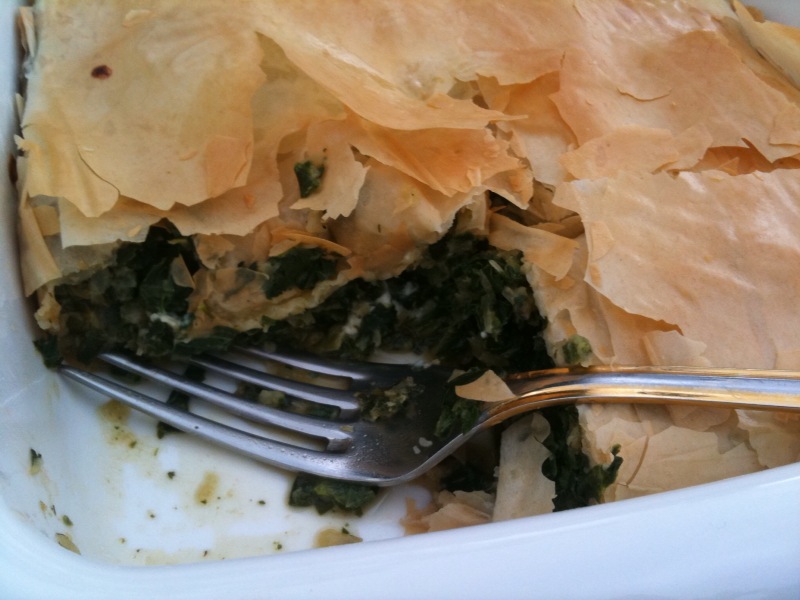My family tends to cook Mediterranean dishes for Easter feasts. The lemon fragrance and bright herbs evoke sunshine and celebrate Spring produce. This year we made a pan of Greek Spanakopita, the famous spinach pie wrapped in flaky phyllo dough. Of course you can easily find pre-made spinach triangles in most grocery freezer cases, but those frozen ones typically have a bland, one-dimensional spinach flavor. This spanakopita recipe from Diane Kochilas’ cookbook The Greek Vegetarian is much more interesting. The filling is complex because the spinach is combined with fresh parsley and dill, sautéed fennel and onions, crumbled feta, and grated nutmeg. It tastes as good as the fab Spanakopita I’ve had in serious Greek restaurants in Chicago.

Phyllo dough is definitely not scary or tricky to work with. You can find it in most any grocery store (except trader joe’s). Just make sure to let it thaw according to instructions before using. I forgot to thaw it once, and it shattered into brittle shards. Diane Kochilas rolls her phyllo from scratch, but I have always bought phyllo sheets from the store.
You can choose between adding cayenne or raisins to the filling. Yesterday’s version had cayenne, but I think I prefer the raisins. It’s up to you.
This recipe makes a whole pan of spanakopita, which is simpler to create than individual triangles. To assemble such a thing, one layers several sheets of phylo dough in a pan, brushing each with olive oil. At some point you pause to pour in the spinach filling. Then arrange several more layers of phylo, also brushed with olive oil. Bake, and voila.
spanakopita recipe
olive oil
2 pounds fresh spinach
3 medium onions
1 fennel bulb
1/2 cup chopped dill
1/2 cup chopped flat-leaf parsley
2 eggs
8 ounces feta
salt
freshly ground black pepper
1/2 teaspoon freshly grated nutmeg
1/4-1/2 teaspoon cayenne (or 2-3 tablespoons dark seedless raisins, depending on your mood)
several sheets of phyllo dough
method
Chop the onions. Chop the fennel bulb. Wash and chop the spinach.
In a large heavy skillet, heat 2 tablespoons olive oil and saute the spinach lightly, just to wilt. Remove the spinach with a slotted spoon and drain in a colander. Heat 2 more tablespoons of olive oil and add the chopped onions and fennel. Cook, stirring with a wooden spoon, until wilted, about 7 minutes.
Place the spinach, fennel, and onions in a large bowl. Chop the dill and parsley, and add them to the bowl. Lightly whisk the 2 eggs in a small bowl, then add them to the mixture, along with 2 more tablespoons of olive oil. Mix well. Crumble the feta, and add it to the bowl, along with the salt, pepper, nutmeg, and cayenne (or raisins).
Preheat the oven to 350F. Lightly oil a pan. Diane Kochilas uses a 12-inch pie pan, but I generally use a rectangular pan. Lay a sheet of phyllo in the pan. The edges will hang over the edges. Brush this phyllo layer with oil. If you don’t have a pastry brush, just drizzle on the oil and rub it around with your (clean) fingertips. Repeat with 3-4 more sheets of phyllo, brushing each with olive oil. Spread the filling evenly over the phyllo.Â

Pull up the outer edges of the phyllo layers, and wrap them around the filling, neatly. Top with 3-5 more layers of phyllo, each brushed with olive oil. To tuck the top layers down, gently tuck them into the edges of the pan using a metal spatula.
Bake for 50 minutes or more, until the phyllo is golden.



Leave a Reply